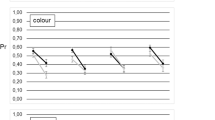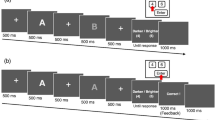Abstract
Synaesthesia is an unusual perceptual phenomenon in which events in one sensory modality induce vivid sensations in another1,2. Individuals may ‘taste’ shapes3, ‘hear’ colours4, or ‘feel’ sounds5. Synaesthesia was first described over a century ago6, but little is known about its underlying causes or its effects on cognition. Most reports have been anecdotal or have focused on isolated unusual cases3,7,8,9. Here we report an investigation of 15 individuals with colour-graphemic synaesthesia, each of whom experiences idiosyncratic but highly consistent colours for letters and digits. Using a colour–form interference paradigm, we show that induced synaesthetic experiences cannot be consciously suppressed even when detrimental to task performance. In contrast, if letters and digits are presented briefly and masked, so that they are processed but unavailable for overt report, the synaesthesia is eliminated. These results show that synaesthetic experiences can be prevented despite substantial processing of the sensory stimuli that otherwise trigger them. We conclude that automatic binding of colour and alphanumeric form in synaesthesia arises after initial processes of letter and digit recognition are complete.
This is a preview of subscription content, access via your institution
Access options
Subscribe to this journal
Receive 51 print issues and online access
$199.00 per year
only $3.90 per issue
Buy this article
- Purchase on Springer Link
- Instant access to full article PDF
Prices may be subject to local taxes which are calculated during checkout




Similar content being viewed by others
References
Baron-Cohen, S. & Harrison, J. E. (eds) Synaesthesia: Classic and Contemporary Readings (Blackwell, Cambridge, 1997).
Cytowic, R. E. Synesthesia: A Union of the Senses (Springer, New York, 1989).
Cytowic, R. E. The Man Who Tasted Shapes (Abacus, London, 1993).
Baron-Cohen, S., Wyke, M. A. & Binnie, C. Hearing words and seeing colours: an experimental investigation of a case of synaesthesia. Perception 16, 761–767 (1987).
Luria, A. R. The Mind of a Mnemonist (Basic Books, London, 1969).
Galton, F. Visualized numerals. Nature 21, 252–256 (1880).
Mills, C. B., Boteler, E. H. & Oliver, G. K. Digit synaesthesia: A case study using a Stroop-type test. Cog. Neuropsychol. 16, 181–191 (1999).
Odgaard, E. C., Flowers, J. H. & Bradman, H. L. An investigation of the cognitive and perceptual dynamics of a colour-digit synaesthete. Perception 28, 651–664 (1999).
Wollen, K. A. & Ruggiero, F. T. Colored-letter synaesthesia. J. Mental Imagery 83–86 (1983).
Baron-Cohen, S., Burt, L., Smith-Laittan, F., Harrison, J. & Bolton, P. Synaesthesia: prevalence and familiality. Perception 25, 1073–1079 (1996).
Dixon, M. J., Smilek, D., Cudahy, C. & Merikle, P. M. Five plus two equals yellow. Nature 406, 365 (2000).
Paulesu, E. et al. The physiology of coloured hearing: A PET activation study of colour-word synaesthesia. Brain 118, 661–676 (1995).
Baron-Cohen, S., Harrison, J., Goldstein, L. H. & Wyke, M. Coloured speech perception: is synaesthesia what happens when modularity breaks down? Perception 22, 419–426 (1993).
Stroop, J. R. Studies of interference in serial verbal reactions. J. Exp. Psychol. 18, 643–662 (1935).
MacLeod, C. M. Half a century of research on the Stroop effect: an integrative review. Psychol. Bull. 109, 163–203 (1991).
Dehaene, S. et al. Imaging unconscious semantic priming. Nature 395, 597–600 (1998).
Forster, K. I. & Davis, C. Repetition priming and frequency attenuation in lexical access. J. Exp. Psychol. Learn. Mem. Cog. 10, 680–698 (1984).
Marcel, A. J. Conscious and unconscious perception: experiments on visual masking and word recognition. Cog. Psychol. 15, 197–237 (1983).
Grossenbacher, P. G. in Synaesthesia: Classic and Contemporary Readings (eds Baron-Cohen, S. & Harrison, J. E.) (Blackwell, Cambridge, 1997).
Acknowledgements
We wish to thank A. Kritikos, M. O'Boyle, P. Wilken and M. Williams for their comments on the manuscript. This work was supported by a grant from the Australian Research Council to J.B.M.
Author information
Authors and Affiliations
Corresponding author
Rights and permissions
About this article
Cite this article
Mattingley, J., Rich, A., Yelland, G. et al. Unconscious priming eliminates automatic binding of colour and alphanumeric form in synaesthesia. Nature 410, 580–582 (2001). https://doi.org/10.1038/35069062
Received:
Accepted:
Issue Date:
DOI: https://doi.org/10.1038/35069062
This article is cited by
-
In Defense of Jñānalakṣaṇā Pratyāsatti
Journal of Indian Council of Philosophical Research (2023)
-
Synesthesia does not help to recover perceptual dominance following flash suppression
Scientific Reports (2021)
-
Apparent physical brightness of graphemes is altered by their synaesthetic colour in grapheme-colour synaesthetes
Scientific Reports (2020)
-
Why Saturday could be both green and red in synesthesia
Cognitive Processing (2016)
-
Do Synesthetic Colors Grab Attention in Visual Search?
Review of Philosophy and Psychology (2016)
Comments
By submitting a comment you agree to abide by our Terms and Community Guidelines. If you find something abusive or that does not comply with our terms or guidelines please flag it as inappropriate.



